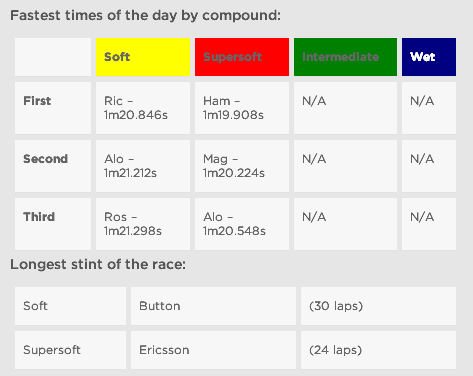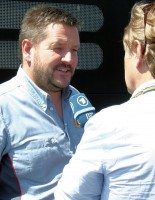Pirelli reviews German Grand Prix, announces tyre choices for Hungaroring
 Pirelli statistics from the German Grand Prix
Pirelli statistics from the German Grand Prix
Nico Rosberg has extended his Formula One championship lead by winning his home grand prix, using a two-stop strategy with one stint on the P Zero Red supersoft followed by two stints on the P Zero Yellow soft tyre. It was the first time that Rosberg had ever finished on the podium at the German Grand Prix, but the 300th podium finish for Williams, courtesy of Valtteri Bottas – on the podium for the third consecutive time.
Rosberg’s team mate Lewis Hamilton made up 17 places by finishing third, having started from 20th on the grid due to an accident in qualifying. Hamilton moved from a two to a three-stop strategy in the race, starting with two stints on the soft tyre and using the extra speed of the supersoft for his final two stints. His last supersoft tyre stint was 17 laps, during which he set fastest lap. This enabled him to close up to Bottas in the closing stages and finish only 22 seconds behind Rosberg, despite a damaged front wing.
The frontrunners on the grid all started on the supersoft tyre, which was around a second per lap faster than the soft tyre. Track temperatures were more than 20 degrees centigrade lower than they had been over the past two days, giving the teams a new dimension, but the expected risk of rain did not materialise. The drivers were able to push as hard as they could with some very close racing from start to finish: the gap at the end between Ferrari’s Fernando Alonso and Red Bull’s Daniel Ricciardo in fifth and sixth was less than a tenth of a second, after 306 kilometres of racing.
“With conditions being a lot cooler than they had been previously, the teams were working in a somewhat unknown area when it came to tyre behaviour compared to the previous two days,” said Pirelli motorsport director Paul Hembery. “We saw plenty of close racing – sometimes very close racing – that also affected tyre wear and degradation. As expected there were between two and three pit stops, with two of the podium finishers, including the winner, stopping just twice. Although he stopped one more time than his direct rivals, Hamilton’s strategy allowed him to come right into contention from a long way down the grid. Our choice of the soft and supersoft ensured plenty of action and some exciting battles from start to finish, despite several different strategies being played out.”
Medium and soft tyres for Hungary
Pirelli and the other F1 teams are now making the 800-kilometre journey from Hockenheim to Budapest for the only back-to-back European grand prix weekend of the season. The Hungaroring, which in 1986 became the first Formula One venue to be built behind the Iron Curtain, is a permanent facility but has many of the characteristics of a street circuit, with tight and twisty corners and a low grip surface that puts the emphasis on mechanical grip. In the past, the race has often been very hot, but rain is not unknown either. Pirelli is bringing the P Zero White medium along with the P Zero yellow soft tyres, which the tyre maker says should provide the right compromise between performance and resistance to the high ambient temperatures. Although the Hungaroring is not seen as being particularly demanding on tyres, the non-stop series of corners mean that the compounds do not get much of an opportunity to cool down over the course of a lap.
“Hungary is well-known for being a tricky layout, where it’s difficult to overtake and to find a perfect set-up for the whole lap,” Hembery commented. “This means that strategy is especially important, as it offers a rare opportunity to gain track position. The weather is normally a talking point in Hungary, but having seen how our tyres performed in the very hot track temperatures of Hockenheim, we’re confident that this shouldn’t be a problem. The tyres we are bringing to Hungary are a step harder, to deal with the increased demands, so we would expect the usual two pit stops – although we will only have a better idea of this once we get to free practice on Friday.”
Pirelli consultant Jean Alesi added that “in the last few years, the Hungaroring has changed in a positive way. It’s a track where you run maximum downforce, because of all the slow corners and low-gear acceleration, but there are also some places now where you can push to the maximum. Getting good traction remains the principal technical challenge, and most of all you need to look after the rear tyres, otherwise you end up with no grip and reduced braking. There are a few key points to know on the circuit. The second corner after the pits, for example, is a downhill left-hander that seems quick but isn’t: you need to stay on the inside to have the best line for the right-hander that follows it. And that’s the key to the Hungaroring really; every corner affects the next one. It’s going to be even more difficult this year I think: all the corners mean that the drivers have to be careful how they modulate the throttle. With the extra torque this year that is no easy task, so it will be quite hard to stick to the ideal racing line every time… ”
Hungaroring from a tyre point of view
The Hungaroring is a circuit that is quite well balanced between traction and braking, and lateral energy. The cars run maximum downforce in order to make the most of the mechanical grip through the slow corners.
The medium tyre is a low working range compound, capable of achieving optimal performance even at a wide range of low temperatures. The soft tyre by contrast is a high working range compound, suitable for higher temperatures. Track temperatures at the Hungaroring are often among the hottest of the year.
The tyres are often subjected to a combination of forces at the Hungaroring. The aerodynamic downforce means that there is a vertical force pushing down onto the tyres, while at the same time there is a lateral force going through the tyres as they negotiate the corners, as well as longitudinal forces from acceleration and braking. All this increases the stress on the structure.
The winning strategy in 2013 was three stops, as Lewis Hamilton took his first win for Mercedes using the medium and the soft tyres. Kimi Raikkonen finished second for Lotus after stopping only twice.




Comments